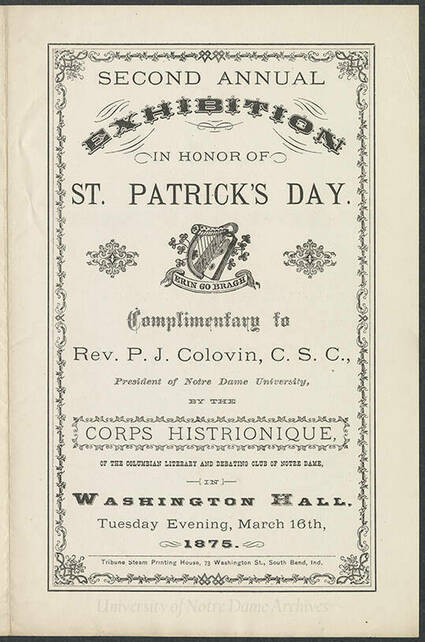
Cian T. McMahon is associate professor of history at the University of Nevada, Las Vegas, with a joint appointment in the Honors College. The author of multiple books and articles on Irish and American immigration history, McMahon won a Hibernian Research Award from the Cushwa Center in 2021 for his project “Paddy’s Day: How Celebrating Saint Patrick Shaped the Irish Diaspora.” In May, Rose Luminiello corresponded with McMahon about his research.
Rose Luminiello: Your most recent book, The Coffin Ship: Life and Death at Sea during the Great Irish Famine (New York University Press, 2021), looks at the difficult journey over from Ireland to the United States, among other destinations. The project that you are currently working on in a way follows on from this history, moving past the unfortunate dead to those fortunate enough to survive transatlantic crossings in the 19th century. Could you tell us more about why you chose to look next at the development and pervasiveness of identity in the Irish diaspora and how St. Patrick’s Day fits into that plan?
Cian McMahon: I’ve been interested in Irish diasporic identity since working on my Ph.D. dissertation, which I ultimately published as a book in 2015 entitled The Global Dimensions of Irish Identity: Race, Nation, and the Popular Press, 1840-1880 (and which Cushwa generously supported with a research grant). While working on that book, I came to realize that the vagaries of Irish identity, in any given place (say, the United States in the antebellum era) were shaped by connections between those local Irish and other Irish around the world. And the network of communication that I focused on the most were newspapers. So, as Irish people in, say, Australia, talked about being Irish-in-Australia, they also imparted to Irish people living elsewhere a sense of being part of a global community.
But this obviously changed over time and space. So I’m interested in using St. Patrick’s Day celebrations to investigate the ways in which these connections and identities changed over 300 years (from the early 1700s to the present).
RL: Your new project takes a transnational approach to understanding the development of an Irish culture in the United States and around the world. Could you say a bit more about this methodology?
CM: There are two ways to do international histories of groups like the Irish. One way is to “compare and contrast” them, looking for ways to understand how their local/regional/national environment shaped how they thought about themselves. So, again, to go back to the mid-19th century, one would explore how the racial identities of Irish people living in a slave society (such as the United States) were different from the racial identities of Irish people living outside slave societies (such as Ireland or Australia). By comparing and contrasting these groups, the thinking goes, we can learn more about the continuities (and discontinuities) in “what it meant to be Irish” at the time.
The second way, rather than compare and contrast the Irish, is to “connect” them. To see how Irish people living in the United States, Australia, and Ireland were actually in contact with each other and impacting each other on issues relating to identity. Personal letters and circulated newspapers are one way to investigate such connections.
Ultimately, however, I am interested in adopting an approach that can “compare, contrast, AND connect” the Irish around the world. So, for this project on St. Patrick’s Day, I want to see how the Irish in different times and places were similar and different from each other. But I’m also committed to figuring out how they impacted each other at the same time. In the end, this is a study of an ongoing conversation between Irish people rather than trying to divine some sort of pure essence of what-it-means-to-be-Irish.
RL: Could you tell us about what types of primary sources you are going to research for this project on St. Patrick’s Day?
CM: I have managed to find some personal letters between people on the subject of St. Patrick’s Day but ultimately, I think that newspapers will be the most important primary source I employ for a few reasons. First, speeches were often printed in the columns of newspapers so that makes them a good place to go for eyewitness accounts of parades, banquets, picnics, etc. Second, I know that Irish people in different parts of the world were reading accounts of celebrations from around the world so this makes newspapers a great way to “connect” Irish people at home and abroad. Third, lots and lots of newspapers have been digitized over the past few years so there is much more material easily available (and I have great support from the interlibrary loan staff at UNLV when I need microfilmed reels sent from elsewhere). Finally, I’ve been reading newspapers for years now as part of my work and so I am familiar with their pros and cons as a primary source. Beyond newspapers, however, I will obviously use pamphlets, letters, event programs, posters, etc.
RL: Your project highlights St. Patrick as a cultural phenomenon far beyond his Roman and Irish origins, and even beyond Catholicism. What have you uncovered in your research about why this saint has developed a particular cultural as well as religious resonance in the United States that transcends ideology?
CM: St. Patrick works as an icon because he is so incredibly flexible, symbolically speaking. He can be whatever people need him to be. This is partly because he lived so long ago and partly because we really, actually, truthfully know very little about him (and everything we know, we learned from the saint himself). So, for example, in a recent reappraisal of Patrick’s life, Roy Flechner muses that it is possible that St. Patrick’s description of his time as a slave in the west of Ireland was actually metaphorical . . . that he told this story about being a shepherd (any surprise that a Christian missionary would describe himself as a shepherd?) as a way to get across a bigger message about being a humble servant of God. We don’t know for sure. And that’s the point. Catholics could describe Patrick as a bishop of Rome. Protestants could describe him as a hard-scrabble, independent operator on the fringe of the known world. It is this flexibility that I am interested in exploring.

RL: In the United States, “Patrick” usually draws an immediate cognitive connection to St. Patrick’s Day and the requisite parades of every March, hallmarks of not just American society but many countries around the world. The day often contains great pageantry and imagery. Will analyzing that symbolism play a role in your new project?
CM: The shamrock has been an enduring symbol of St. Patrick and his mission in Ireland for centuries and it obviously carries down to the present day. But there are other parts of the symbolism of St. Patrick that were later additions and used to symbolize Patrick as a venerable churchman to folks who were often illiterate. The classic image of Patrick, for example, has him clothed in green, with a mitre on his head and a bishop’s crook in his hand. Well . . . clergy did not start wearing mitres until 200 years after Patrick died in the fifth century. They didn’t start carrying crooks until the 12th century. And green probably only became associated with Irish ethnic identity in the late 18th or 19th century (it was blue before that).
In other words, the symbolism surrounding Patrick is as complicated (and often anachronistic) as anything else about the man. Analyzing changes in the deployment of those symbols offers fruitful insight into the ways in which Irish identity has changed over time and space.
RL: Your project is an ambitious international history—has your research led you to notice any significant differences in how diasporas think of themselves as Irish or portray themselves within religious identity and symbolism even across the same celebration of St. Patrick as a national hero (as standing against the British or as against Rome)?
CM: Each chapter of my new book is going to focus on a very specific time and place before zooming out to see how other Irish people around the world were identifying at the same time. I’m still in the early stages of this project but some examples are coming through. So, for example, in the mid-1800s, if you were an Irish person celebrating St. Patrick’s Day in New York City, your first toast of the evening would probably be to “The Day We Celebrate” and your second would probably be to “The United States of America.” Your third might be to “George Washington.” And this makes sense because Irish people in the United States were eager to prove to anti-Catholic nativists that they were just as good at being republicans as Americans were.
But for the Irish in Australia, which was still a colony of Great Britain, the first toast of a St. Patrick’s Day banquet was probably to “The Queen,” the second toast was to “Prince Albert and the rest of the Royal Family,” and the third toast might have been to the colony’s governor (the official representative of the monarchy). Why? Because while they were celebrating being Irish, these folks were also being careful to make sure that they were seen as loyal citizens in their new homes. Just like the Irish in America. But totally different.
So, this project will seek to explore this ongoing conversation by comparing, contrasting, and connecting Irish celebrations of St. Patrick’s Day since the early 1700s.
Rose Luminiello is a postdoctoral fellow in the Keough School of Global Affairs at the University of Notre Dame. From 2019 to 2022, she was a research associate at Notre Dame’s Cushwa Center.
Originally published by at cushwa.nd.edu on July 15, 2022.